<< Previous | Displaying results 4426-4450 of 6769 for "" | Next >>
The Medical Case was one of twelve war crimes trials held before an American tribunal as part of the Subsequent Nuremberg Proceedings. The trial dealt with doctors and nurses who had participated in the killing of physically and mentally impaired Germans and who had performed medical experiments on people imprisoned in concentration camps. Sixteen of the defendants were found guilty. Of the sixteen, seven were sentenced to death for planning and carrying out experiments on human beings against their will.…

The Soviet Union occupied Lvov in September 1939, according to secret provisions of the German-Soviet Pact. Germany invaded the Soviet Union on June 22, 1941. After a week of bitter fighting, German forces occupied Lvov. They discovered that the Soviet Secret Police had massacred thousands of prisoners, mostly Ukrainian nationalists, before fleeing from the city. This footage shows the removal of the bodies of some of those massacred. The Germans claimed that the city's Jewish population had supported the…
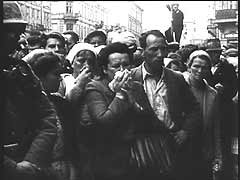
The Soviet Union occupied Lvov in September 1939, according to secret provisions of the German-Soviet Pact. Germany invaded the Soviet Union on June 22, 1941, occupying Lvov within a week. The Germans claimed that the city's Jewish population had supported the Soviets. Ukrainian mobs went on a rampage against Jews. They stripped and beat Jewish women and men in the streets of Lvov. Ukrainian partisans supported by German authorities killed about 4,000 Jews in Lvov during this pogrom. US forces discovered…
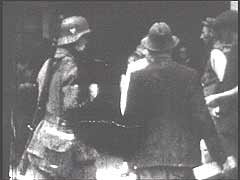
Julius Streicher, Nazi leader and publisher of the antisemitic newspaper "Der Stuermer" (The Attacker), makes a speech accusing Jews of trying to control the world and living by the exploitation of non-Jews. According to Streicher, the only answer for Germany is to solve the "Jewish question."
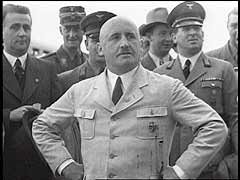
Hitler speaks before the Reichstag (German parliament). Amid rising international tensions, he tells the German public and the world that the outbreak of war would mean the end of European Jewry.
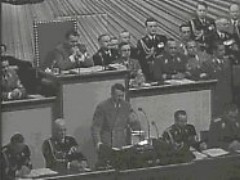
In Berlin, Germany, officials from Nazi Germany, Fascist Italy, and Imperial Japan sign the ten-year Tripartite Pact (the Three-Power Agreement), a military alliance. The pact sealed cooperation among the three nations (Axis powers) in waging World War II. This footage comes from "The Nazi Plan," a film produced and used by the United States in the prosecution at the Nuremberg trials.
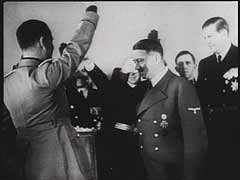
In 1936, Germany and Italy signed a military alliance. The two powers formed the so-called Berlin-Rome Axis. This footage shows Italian Fascist leader Benito Mussolini's state visit to Germany in September 1937. He met with Hitler in Munich and the two leaders also toured other parts of Germany. During the state visit, Mussolini attended a military parade in Berlin, Germany's capital. Although both dictators declared their desire for peace, Germany would begin World War II in 1939. Italy would then enter…
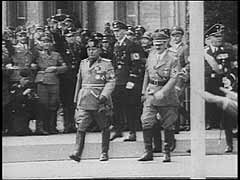
Most Allied prisoners of war (POWs) were treated well compared to inmates of concentration camps. But, as former Dutch POW Captain Boullard explains here at Dachau concentration camp, some were subject to severe beatings and forced to work in harsh labor assignments.
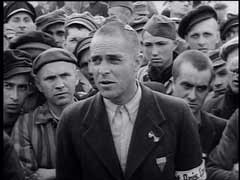
Germany launched its western offensive on May 10, 1940. German paratroopers landed in the Netherlands on the first day of the German attack on that country. They seized key bridges and fortifications, compromising Dutch defensive positions. This footage shows the German air force (Luftwaffe) dropping paratroopers near Rotterdam. Within days, the Netherlands was defeated. The country surrendered to Germany on May 14. The Dutch government and Queen Wilhelmina fled to exile in Great Britain.
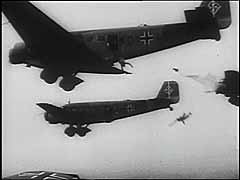
German forces invaded western Europe in May 1940. As part of their strategy to defeat Britain and France, German forces invaded neutral Belgium. Little more than two weeks after the German invasion of Belgium, King Leopold III ordered the surrender of the Belgian army. In this footage a Belgian officer signs the surrender and thousands of refugees flood the streets as German forces move through Belgium.

Germany invaded France in May 1940. This footage shows German tanks, artillery, and divebombers attacking the Maginot Line, a series of French fortifications intended to protect France's border with Germany. The main German assault, however, went to the north through Luxembourg and bypassed the Maginot Line. German forces entered Paris on June 14, 1940. Little more than a week later, defeated France signed an armistice with Germany.
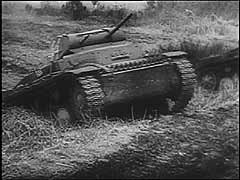
The German western campaign in May 1940 decisively defeated the British and French forces arrayed against it. By the end of May, the Allies began the withdrawal of British and French forces from the Continent to prevent their surrender or destruction. The evacuation effort centered on the French coastal town of Dunkirk. As German forces completed their conquest of France, more than 1,000 vessels--including small civilian yachts and fishing boats--ferried Allied forces across the English Channel to Great…
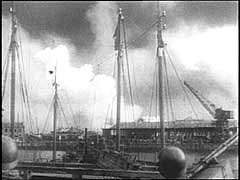
After the defeat of France in June 1940, Germany moved to gain air superiority over Great Britain as a prelude to an invasion of Britain. Despite months of air attacks, Germany was not able to destroy Britain's Royal Air Force (RAF). In the fall of 1940, the invasion was indefinitely postponed. The German bombing campaign against Britain continued until May 1941. The Germans ultimately halted the air attacks primarily because of preparations for the invasion of the Soviet Union in June 1941.
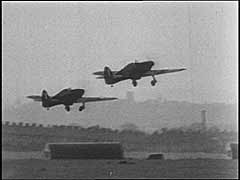
After the defeat of France in June 1940, Germany moved to gain air superiority over Great Britain as a prelude to an invasion of Britain. During almost nightly German air raids (known as "the Blitz") on London, the civilian population of the city sought refuge--as shown in this footage--in air raid shelters and in London's subway system (called the "Underground" or the "Tube"). Despite months of air attacks, Germany was not able to destroy Britain's Royal Air Force (RAF). In the fall of 1940, the invasion…
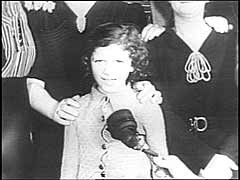
Adolf Hitler became chancellor of Germany in January 1933. Soon thereafter, terror actions against opponents of Nazism began: Jews were a major target in these campaigns. Many Jews were subjected to public humiliation or arrest, and others were forced to quit their posts. Anti-Jewish measures climaxed with the April 1, 1933, boycott of Jewish-owned businesses. This footage depicts a Jewish anti-Nazi march in Chicago.
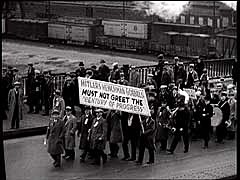
The American Jewish Congress was among the first groups in the United States to oppose Nazism. It held a mass rally as early as March 1933, soon after Hitler rose to power in Germany, and continued to hold rallies throughout the war years. The American Jewish Congress organized this anti-Nazi march through Lower Manhattan. The event coincided with book burning in Germany.
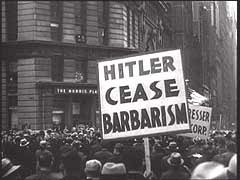
On November 9, 1938, the Nazis led a nationwide pogrom against Jews. During the pogrom, known as "Kristallnacht" (the "Night of Broken Glass"), bands of Storm Troopers (SA) destroyed thousands of Jewish-owned businesses and hundreds of synagogues. Almost 100 Jews were killed in the process. This footage shows scenes from a protest rally in New York City. Rabbi Stephen S. Wise voiced the outrage of the American Jewish community. As part of an official protest by the United States government against the…
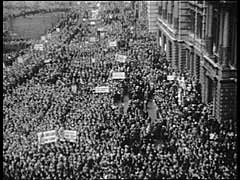
Although constrained by powerful isolationist sentiment in the United States, President Roosevelt was determined to help democratic Great Britain continue the war against Nazi Germany. Even as he promised to keep the United States neutral in the European war, Roosevelt ordered the expansion of military construction and pledged--as shown in this footage--that the United States would serve as the "great arsenal of democracy." In March 1941, Congress approved Lend-Lease aid for Britain. Britain ultimately…
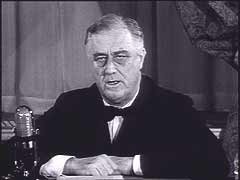
After word reached America of the Nazi killing of European Jewry, pressure mounted on the Roosevelt administration to help European Jews. To spur action, playwright Ben Hecht prepared a memorial to the Jewish victims of Nazi persecution, "We Will Never Die." The pageant, sponsored by the Zionist Revisionist Bergson Group, was part of a mass demonstration at Madison Square Garden in New York City. Later seen in other US cities, the show was part of the Bergson Group's effort to pressure Washington to act…
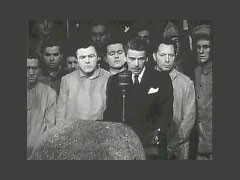
The Germans invaded the Soviet Union in June 1941 (Operation "Barbarossa"). German forces occupied Vitebsk in the northeastern region of Belorussia on July 11. Soviet forces seized the initiative from the Germans after the battle of Stalingrad in late 1942 and early 1943. The Soviet army liberated Vitebsk on June 26, 1944, during their summer 1944 offensive. This footage shows military units involved in the fighting and German soldiers captured during the campaign. By the end of the summer, the Soviet…
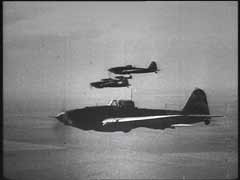
In June 1944, the Soviet Union launched a massive offensive against the German army in eastern Europe. Soviet forces reoccupied Vilna in July 1944, after bitter street fighting with the German garrison. They then continued on toward Kovno, the capital of Lithuania. This Soviet footage depicts the battle for Vilna and the final reoccupation of the city by the Soviet army.

After the sudden death of Franklin D. Roosevelt in April 1945, Vice President Harry S. Truman became president of the United States. Here, President Truman meets with the heads of state of the Soviet Union and Great Britain (Joseph Stalin, Winston S. Churchill, and later Clement Attlee) in Potsdam, near Berlin, to discuss the future of defeated Germany. The leaders agreed to the partition of Germany and Berlin, Germany's capital city, into four zones of occupation: British, French, American, and Soviet.…
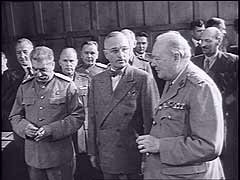
The Buchenwald camp was one of the largest concentration camps. The Nazis built it in 1937 in a wooded area northwest of Weimar in central Germany. US forces liberated the Buchenwald camp on April 11, 1945. When US troops entered the camp, they found more than 20,000 prisoners. This footage shows scenes that US cameramen filmed in the camp, survivors, and the arrival of Red Cross trucks.
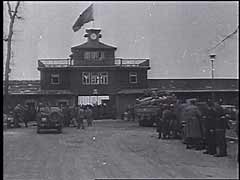
US forces liberated the Buchenwald concentration camp in Germany in April 1945. Here, US soldiers escort German civilians from the nearby town of Weimar through the Buchenwald camp. The American liberating troops had a policy of forcing German civilians to view the atrocities committed in the camps.
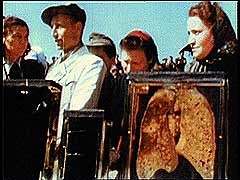
US forces liberated the Buchenwald concentration camp on April 11, 1945. This footage records examples of Nazi atrocities (shrunken head, pieces of tattooed human skin, preserved skull and organs) discovered by the liberating troops.
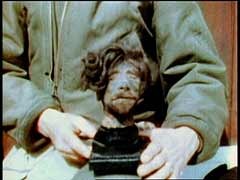
We would like to thank Crown Family Philanthropies, Abe and Ida Cooper Foundation, the Claims Conference, EVZ, and BMF for supporting the ongoing work to create content and resources for the Holocaust Encyclopedia. View the list of donor acknowledgement.